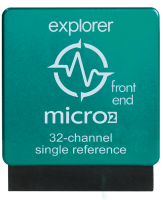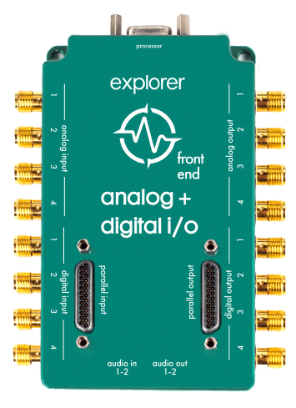System Architecture

The Explorer System
Modular Design for Specialized Applications
Choose from a variety of individual components to build a system as unique as your applications.
An Explorer processor and a single Front End are all you need to start recording.
Additional Front Ends can be added to increase the number of recording channels or to acquire different physiological signals. Connect an I/O module to control or communicate with external devices through analog and/or digital inputs and outputs.
Link two processors together and operate them as a single system for high channel counts (up to 1024) or for applications such as hyperscanning.
Powered by a wall outlet or internal battery. External batteries are available to extend untethered operational time.
Can be controlled by a computer using an ethernet cable or via Wi-Fi to eliminate cables.
Run the system independently of the computer by preprogramming your experimental controls. Front buttons can be programmed to load custom software or provide feedback during operation.

The Processor
One Explorer Line, Three Processors
The Summit, the Quest HD, and the Quest HD+Stim
With all three processors featuring the same industry-leading core technology, we’ve made it easy to build a system around your specific applications.
The Summit is compatible with all Explorer Front Ends and can record up to 512 channels, making it perfect for invasive and high channel-count applications.
Both the Quest HD and Quest HD+Stim are compatible with Front Ends that are optimized for non-invasive applications. Quest HD processors are available in 64- and 256-channel versions.

The Front Ends
Different Front Ends
for Different Modalities
Connect multiple types of Front Ends to a single Explorer processor for seamless multi-modal recordings.
The Explorer line offers four distinct families of Front Ends to provide ideal recording and stimulation capabilities for any electrode type or physical location.
The EEG, the Macro, the Micro2, and the Physio are each designed to have optimal technical specifications for a specific recording or stimulation modality. Stimulation-capable versions are available for all but the Physio family.

EEG and EEG+TES
Designed with EEG specifically in mind, the EEG family of Front End can be used with nearly any non-invasive surface electrode and is ideal for surface recordings that do not require bipolar or true-differential referencing. For stimulation, the EEG+tES Front End can deliver transcranial (tES), transcutaneous nerve (TENS), or spinal stimulation (TSS) through the same surface electrodes used during recording.

Macro and Macro+Stim
The Macro family of Front Ends was designed to easily connect to standard clinical invasive electrodes. Recording specifications are optimized for applications such as high-resolution ECoG or sEEG. The Macro+Stim Front End features a maximum stimulation current that matches common clinical stimulators, while incorporating novel safety features to prevent excessive discharge.

Micro2 and Micro2+Stim
Ideal for high-resolution, invasive recordings, the Micro2 family of Front Ends is optimized for use with high-impedance microelectrodes and can record single-units. Stimulate and record on all 32 channels simultaneously with the Micro2+Stim for unparalleled stimulation capabilities.

Physio and PhysioD
The Physio family of Front Ends was designed specifically for electromyography. Perform shared reference or true-differential recordings with the 32-channel Physio or the 16-channel PhysioD. Both variations feature technical specifications that are ideal for any type of electrophysiology from the body, such as ECG or non-invasive peripheral nerve recordings.




The I/O Modules
Interface with Other Research Equipment
Select from three different options to meet any analog and digital I/O needs.
Whether your specific application calls for interfacing with analog devices, digital devices, or both, the Explorer line has you covered with the Analog I/O, Digital I/O, and Analog+Digital I/O modules.
Use the Analog I/O and the Digital I/O modules together for 28 analog inputs and outputs and 20 digital inputs and outputs. The combined Analog+Digital I/O module provides a condensed version in a single package.

Connectivity
Power and
Ethernet
Wired power and communication
Each Explorer processor comes with a power supply to connect to a wall outlet for uninterrupted, wired power. The supply includes a standard Ethernet jack for wired communication to a computer or network.
For wireless operation, Explorer processors include an internal battery, internal data storage, and Wi-Fi communication. Extend wireless operation with an external battery pack.








